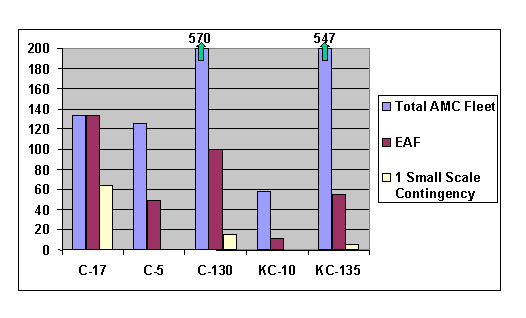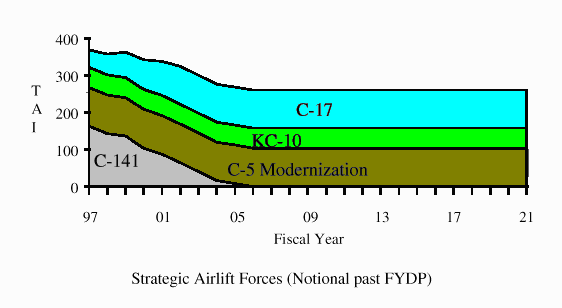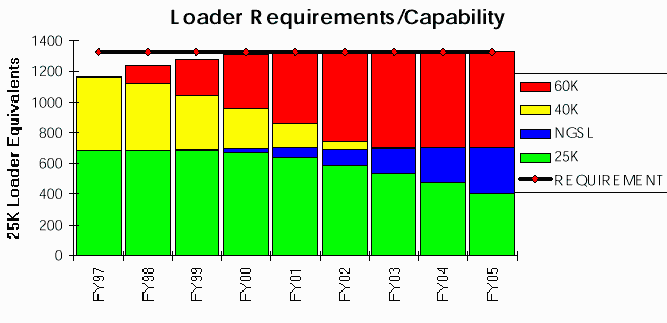


Airlift Cargo Aircraft
Airlift operates across the range of military operations
performing six broad tasks: deployment, employment,
redeployment, sustainment, aeromedical evacuation (AE), and
military operations other than war, such as foreign humanitarian
assistance and noncombatant evacuation operations. Airlift
is a cornerstone of global force projection. It provides the
means to rapidly deploy and redeploy forces, on short notice,
to any location worldwide. Airlift�s characteristics � speed,
flexibility, range, and responsiveness � complement other
US mobility assets. The United States operates three distinct
airlift forces; intertheater or strategic, theater or intratheater,
and organic airlift forces. Airlift delivery is accomplished by
two basic modes, airland or aerial delivery. Airland is the
most frequently used delivery method and encompasses all
situations where personnel and cargo are onloaded and off-loaded
while the aircraft is on the ground. Aerial delivery
includes all methods of delivering personnel, equipment, and
supplies from an airborne aircraft.
The Army has the largest requirement for common-user airlift.
In particular, Army light infantry, airborne, and air assault forces
rely heavily on airlift for deployment, sustainment,
employment, and redeployment.�The Navy depends on
common-user airlift to sustain forward deployed operations
with personnel, materiel, and mail from the continental United
States (CONUS) to overseas bases and forward logistic sites.
Marine forces require common-user airlift for deployment
into a theater as part of a maritime prepositioning force as an
air contingency force or as a Marine expeditionary force afloat
and/or ashore. Sustained Marine air-ground task force
operations require strategic and intratheater common-user
airlift support. Depending on the operation, the Air Force
tends to be the second largest customer of common-user airlift.
For deployment, Air Force unit aircraft self-deploy; however,
unit support personnel and equipment require airlift to the
destination with, or before, the deploying unit aircraft. Special
operations forces (SOF) have specially configured aircraft
dedicated to special operations. SOF are augmented by
common-user airlift support. As a branch of the Armed Forces
and a non-DOD agency, the Coast Guard�s organic airlift is
normally sufficient to satisfy its airlift requirements. Other non-DOD
agencies use DOD airlift for activities such as
noncombatant evacuation operations, counterdrug operations,
foreign humanitarian assistance, and domestic support
operations. Non-DOD agencies may use common-user airlift
providing the DOD mission is not impaired.
Airlift and air refueling forces provide speed and flexibility in deploying, employing, and sustaining America�s military forces. Air mobility forces operate as part of a larger joint warfighting team, working with air, land, and naval forces to meet operational requirements for the unified commanders. Air mobility missions include the airlift and/or airdrop of troops, passengers, supplies, and equipment to locations around the globe, as well as air refueling for Air Force, other services, and allied aircraft. Air mobility forces also provide worldwide aeromedical evacuation of patients, participate in special operations, and support other national security requirements.
|
AIRLIFT FORCE HIGHLIGHTS
|
| |
FY 1993
|
FY 1994
|
FY 1995
|
FY 1996
|
FY 1997
|
FY 1998
|
FY 1999
|
FY 2000
|
FY 2001
|
|
Intertheater Airlift (PMAI)a
|
C�5
|
109
|
107
|
104
|
104
|
104
|
104
|
104
|
104
|
104
|
C�141
|
214
|
214
|
199
|
187
|
163
|
143
|
136
|
104
|
88
|
KC�10b
|
57
|
54
|
54
|
54
|
54
|
54
|
54
|
54
|
54
|
C�17
|
2
|
9
|
17
|
22
|
24
|
30
|
37
|
46
|
58
|
|
Intratheater Airlift (PMAI)a
|
C�130c
|
380
|
424
|
428
|
432
|
430
|
425
|
425
|
425
|
425
|
a PMAI = Primary mission aircraft inventory for active and reserve components. The numbers shown reflect only combat support and industrial funded PMAI aircraft and not development/test or training aircraft.
b Includes 37 KC�10s allocated to an airlift code.
Land-based aircraft with a primary mission of moving small numbers of passengers passengers and small quantities of
time-critical cargo are classified by the Department of Defense as Operational Support Airlift (OSA) aircraft. Most
OSA aircraft are derivatives if commercial executive transports or the types of aircraft flown by commuter (or "feeder")
airlines, although a few are as large as full-sized airliners. This is not a particularly sharp definition, however. For
example, Navy Reserve C-9B aircraft (similar to the civilian DC-9 airliner) are classified as OSA, while Air National
Guard T-43 arcfraft (similar to the civilian 737 airliner) are apparently not.
Two DOD-wide initiatives were recently completed to reorganize OSA operations. In an effort to minimize
cross-service duplication, all CONUS OSA scheduling were consolidated under the U.S. Transportation Command at
Scott AFB in the Joint Operational Support Airlift Center (JOSAC). And to align the force structure with the force
size, a 30% reduction of OSA aircraft, mostly allocated evenly across the services, was directed. The Army retired all
of it's U-21's, and the Air Force transfered the nearly all of its C-12's and C-26's to the Army. At the same time there
have been a number of service-specific initiatives. Changes in Army OSA have been the most dramatic, with
procurement of about 50 new C-23B and UC-35A aircraft and transfer of most Army OSA functions to the Army
National Guard and the Army Reserve.
Small Scale Contingency airlift requirements might include [for 2-3 months] a total of 79 aircraft. Some 43 C-17s would be used [15 SOLL II, 12 Direct Delivery, 16 Intra-theater], while 40 C-130s would include 8 Theater Assigned and 8 Theater Deployable aircraft. Additionally, 18 Group B KC-135s and additional Special Operations aircraft would be involved.

 The Mobility Requirements Study Bottom-Up Review Update and analysis of preposition cargo set the airlift requirement for a two major regional contingencies (MRC) scenario at 49.7 million ton miles per day (MTM/D). Fully mobilized, the Air Reserve Component and active duty contributes approximately 61 percent, while the Civil Reserve Air Fleet (CRAF) provides
39 percent. Air Mobility Command�s force structure is not only based on the requirements for a two-MRC scenario, but also on unique military requirements such as strategic brigade airdrop, lesser regional contingencies, and peace keeping/peace enforcement.
The Mobility Requirements Study Bottom-Up Review Update and analysis of preposition cargo set the airlift requirement for a two major regional contingencies (MRC) scenario at 49.7 million ton miles per day (MTM/D). Fully mobilized, the Air Reserve Component and active duty contributes approximately 61 percent, while the Civil Reserve Air Fleet (CRAF) provides
39 percent. Air Mobility Command�s force structure is not only based on the requirements for a two-MRC scenario, but also on unique military requirements such as strategic brigade airdrop, lesser regional contingencies, and peace keeping/peace enforcement.

| AIRLIFT AIRCRAFT COMPARISON |
C-5 |
C-17 |
C-130H |
C-141B |
KC-135R* |
KC-10 |
747-200F |
| MAX TAKEOFF
GROSS WEIGHT (LBS.) 2.5 g |
769,000 |
523,000 |
155,700 |
323,000 |
322,500 |
593,000 |
836,000 |
| OPR WT EMPTY (LBS.) |
374,000 |
236,600 |
80,000 |
149,000 |
135,000 |
244,500 |
344,300 |
| MAX ACL (LBS.) 2.5G |
216,000 |
140,800 |
43,000 |
69,725 |
60,000 |
169,500 |
243,000 |
| MAX PALLET LOAD |
36 |
18 |
5.5 |
13 |
6 |
27 |
50 |
| WARTIME PALOAD DELIVERED 2,900 NM
(LBS.) |
188,000 |
172,000 |
22,000 |
72,000 |
60,000 |
169,000 |
243,000 |
| RANGE (NM)WITH MAX ACL 2.5G |
2,250 |
2,840 |
1,000 |
2,160 |
5,000 |
3,100 |
3,600 |
| FERRY RANGE (NM) |
6,200 |
5,290 |
4,200 |
4,600 |
9,700** |
9,800 |
7,300 |
| AVG CRUISE SPEED/MACH |
450/.77 |
450/.77 |
280/.46 |
425/.74 |
450/.77 |
481/.82 |
490/.84 |
| TO GND RUN (FT) |
7,800 |
7,600 |
4,700 |
5,900 |
6,000 |
9,300 |
8,800 |
| LND ROLL (FT): MAX ACL & 500
NMS (SL/STD Day) |
2,750 |
1,880 |
2,400 |
2,180 |
3,000 |
2,800 |
5,900 |
| AMC MIN WARTIME RUNWAY LXW (FT) |
5000x90 |
3000x90 |
3000x90 |
5000x90 |
7000x147 |
6000x90 |
7400x90 |
| MIN 180 DEGREE TURN FT |
143 |
90 |
47 |
137 |
130 |
142 |
142 |
| AIRCRAFT LENGTH (FT) |
248 |
175 |
133 |
168 |
136 |
182 |
232 |
| Aircraft Wing Span (FT) |
223 |
171 |
100 |
160 |
131 |
165 |
196 |
| Aircraft Height (Ft) |
65 |
55 |
39 |
40 |
38 |
58 |
63 |
| Cargo Compartment Width |
19 |
18 |
10 |
10 |
13 |
18 |
19 |
| Height |
14 |
12 |
9 |
9 |
7 |
8 |
10 |
| Length |
145 |
88 |
52 |
104 |
65 |
125 |
185 |
| THRUST (LBS.) /Eng |
41,000 |
40,700 |
4,300hp |
21,000 |
22,200 |
52,500 |
52,500 |
| AIRCRAFT NUMBERS |
104 |
24 |
442 |
161 |
472 |
54 |
N/A |
* Since the majority of KC-135s are dedicated
to wartime air refueling, their impact to wartime airlift is
limited.
**Range with 120,000 pounds (54,000 kilograms)
for fuel transfer
The current fleet of Material Handling Equipment (MHE) is short in numbers, lacks high-reach capability, is beyond its service life, and is expensive to maintain. MHE represents the weakest link in the air mobility process. Both the 40K loader and 25K loader cannot reach the cargo loading height of commercial wide-body aircraft. The aging fleet of 25K loaders, the backbone of the theater and smaller port capability, is becoming increasingly unreliable--it too requires replacement. The average age of the 40K loader is 23 years, using original registration numbers, while their life expectancy, when purchased, was 8 years. Sixty-nine percent of the 25K loader fleet is comprised
of old, deteriorating Emerson and Con Diesel loaders that are reaching the end of their service life extension.
The cargo handling shortfall will be solved with the procurement of new MHE. An acquisition strategy started in the mid-80s for a new
super loader (Tunner, 60K), one that could replace the 40K, yet reach wide-body aircraft. The Tunner (60K) loader and next generation small loader acquisitions provide the capability to support all commercial and
military cargo aircraft. The modernization of the MHE fleet is AMC's second highest equipment priority after the acquisition of the C-17. With continued funding, the full buy of 318 Tunner loaders possesses the capability to solve the large cargo handler shortfall.
Delivery of the Next Generation Small Loader (NGSL) must begin in FY00.

Sources and Resources
http://www.fas.org/man/dod-101/sys/ac/lift_comp.htm
Maintained by Robert Sherman
Originally created by John Pike
Updated Friday, November 19, 1999 9:14:12 AM








